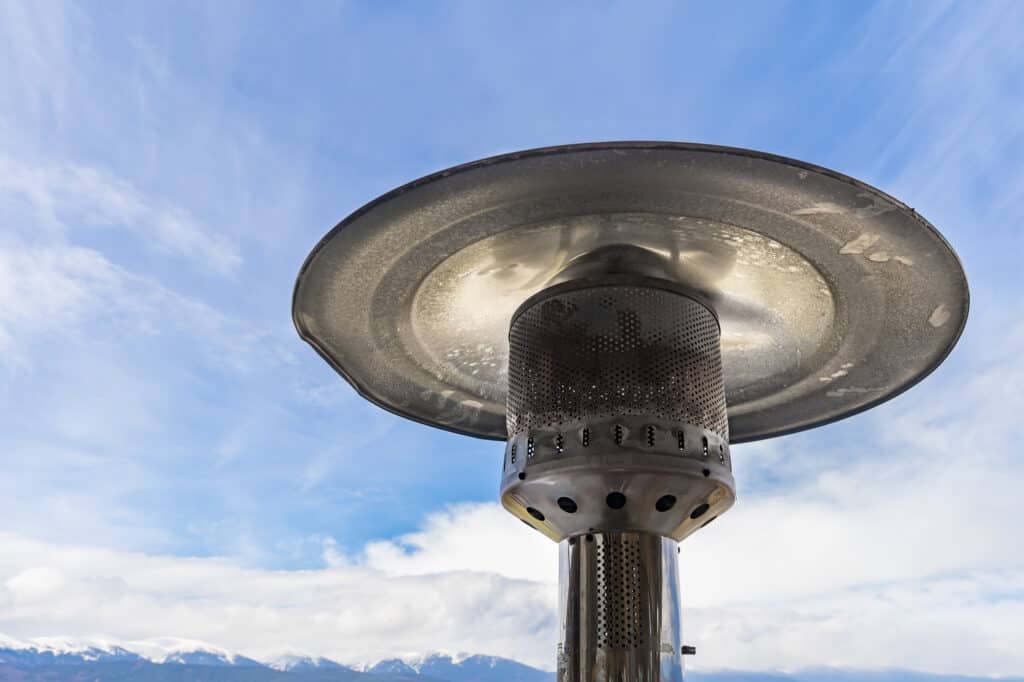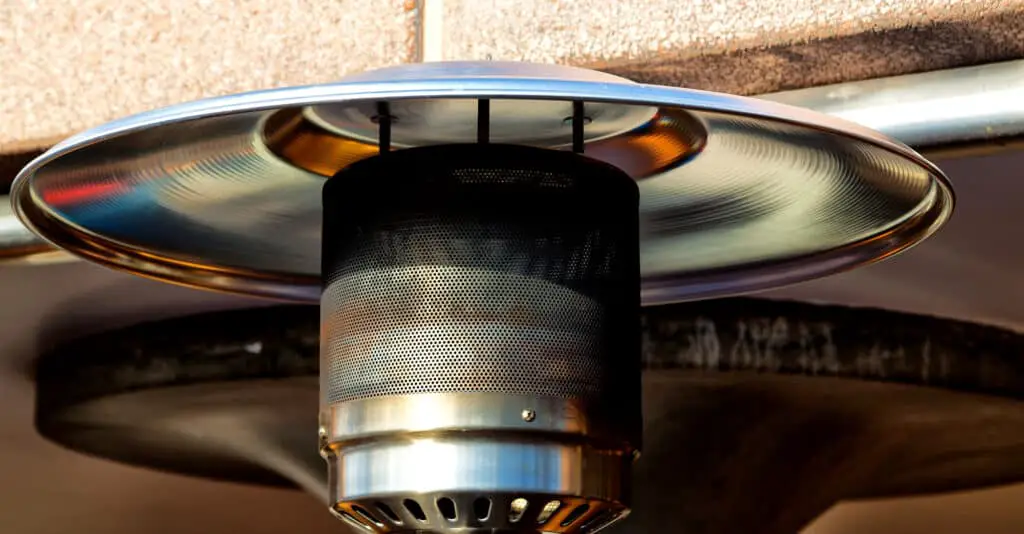If you have a heater with a pilot ignition system, you can manually light your patio heater by pushing and turning the control knob. Then, press the stick button several times to ignite the pilot flame.
However, if your patio heater doesn’t have a pilot ignition system, you’ll need to use the gas control knob to light it up.
Patio heaters are popular because they allow you to enjoy outdoor living even in cooler weather, without having to go back inside.
But lighting one up quickly and safely might seem more daunting than it really is.
In this article, we will explore these steps in more depth.
Before attempting to manually light your patio heater, it is crucial to take the necessary precautions.
We’re an affiliate: We hope you love the products we recommend! Just so you know, we may collect a share of sales or other compensation from the links on this page. Thank you if you use our links, we really appreciate it!

Table of Contents
Precautions to Take When Lighting Up a Patio Heater
Before lighting up a patio heater, it’s important to take some safety precautions and keep in mind some beginner’s tips.
Ensure adequate space around the patio heater, even if under cover.
- The first thing you need to be mindful of is the gas regulator. To prevent gas from leaking out when you’re not using your patio heater, you need to use a device that regulates the gas flow. Once you’re done using the heater, make sure to turn off the regulator. Be sure to follow the instructions on the label for proper usage.
- Always keep a nose out for gas leaks. If you detect the smell of gas when you turn on the regulator, it’s likely that there is a leak in the gas delivery pipe. A pipe with no leaks will make a specific sound when gas flows through it. If you notice any abnormalities with your gas pipe, your best option is to have it replaced without delay.
- Keep your patio heater from any combustible and flammable material. Materials that can be easily ignited include paper, plastic, wood, and other similar substances.
- Keep the gas pipe and the burner of your patio heater clean. To ensure a smooth gas flow, it is important to make sure that the gas delivery pipe is free from any clogs. You can detach the pipe from the gas tank located at the base of the heater and blow through it to ensure it is clear. Additionally, the burner must be kept clean to ensure an even flame when the heater is turned on. Regularly check for any blockages or dirt to maintain optimal performance.
- Make sure the gas tank is full before you proceed on with lighting the heater. To ensure that your patio heater lasts as long as you need it, it’s important to check whether the tank is full by lifting the base of the heater. This beginner’s tip is helpful in avoiding any interruptions to your outdoor plans. If the tank is not completely filled, it may run out of fuel, which could be inconvenient and cut your outdoor activities short.
Want to extend the life of your patio heater? Using a cover is an easy and effective way to protect your patio heater from the rain without having to worry about moving it around.

Manually Light Your Patio Heater With an Automatic Ignition System
There are basically two types of patio heaters. In this section, we will look at how you can light up a patio heater with an automatic ignition system:
- The first thing to do is to push and turn the control knob to the pilot position. Hold the position for at least 45 seconds until the pilot flame ignites, which can be checked through the match lighting hole.
- Now, while holding on to the knob, press the stick button a few times (at least five times) to get the igniter working. If a regular lighter doesn’t work, try a long candle lighter.
- Allow the control knob to pop out once a flame gets going automatically. You can adjust the knob to your desired temperature for the room.
Manually Light Your Patio Heater Without an Automatic Ignition System
Let’s take a look at the second type of patio heater that does not have an automatic ignition system or pilot light.
- First, make sure your heater is off. You can attach the gas tank and slowly turn it on until it opens.
- Now, depress the gas control knob and turn it to a low position. Do not let go of the knob just yet.
- While keeping the control knob depressed, press the ignition button a few times (at least five times) to get the igniter working. If this doesn’t seem to work, you can insert a long candle lighter through the lighting hole and use it instead.
- You must keep the gas control knob depressed for an additional 45 seconds. This will allow the gas to flow without any hindrances.
- You may finally let go of the control knob and then turn it to the desired degree. Make sure to choose the amount of heat perfect for the vicinity.
Troubleshooting Guide: Can’t Get Your Patio Heater to Work?
You should, under normal circumstances, be able to get your patio heater to work using the steps outlined above. But if you’re lighting one up every evening or so, you’re eventually bound to run into a few problems.
Here are some common reasons that explain why your patio heater might be having trouble lighting up:
- The gas tank is empty. It’s surprising how often people struggle to light a patio heater, only to discover later that the gas tank was empty all along. As we mentioned earlier in the safety and beginner’s tips section, it’s a good practice to check if the gas tank is full before lighting up the heater. To check for a full tank, simply lift the base of the patio heater.
- The gas regulator is turned off. It is a common mistake to forget to turn on the gas regulator when using a patio heater, especially after turning it off for safety reasons. Therefore, it’s important to double-check and ensure that the regulator is turned on before using the heater.
- The gas tank is not hooked on properly. One common issue with gas heaters is improper connection of the gas tank to the gas pipe, which can prevent the heater from igniting. Fortunately, this problem can often be resolved by disconnecting the gas tank and then reconnecting it properly.
- A clog in the burner or pipe. As we have mentioned earlier, if you are facing difficulty igniting your patio heater, it may be due to a clog or blockage in the burner or gas pipe. You can fix this issue by removing the burner and gas pipe, cleaning them thoroughly, and attaching them back in place.
- A clog in the bug screen. A bug screen is attached to a patio heater to prevent insects from being burnt in the flame that attracts them. However, if the screen accumulates too many bugs, it can obstruct the flow of heat. Therefore, if your patio heater appears to be functioning correctly but is not providing sufficient heat, this may be the cause.
It’s also a good idea to make sure your patio heater isn’t exposed to unnecessary elements. This can include keeping it out of rainstorms or utilizing a cover to ensure less weather damage.
And while a lot of patio heaters can still work in the rain, patio heaters are not waterproof, long-term exposure to rain can still cause faster wear and tear.

Conclusion
Patio heaters are ideal for outdoor use during cooler seasons. Fortunately, lighting them up is not as difficult as it may seem.
There are two ways to light these heaters: with an automatic pilot light ignition system or without.
In this article, we provided step-by-step instructions for lighting both types.
We also provided troubleshooting tips for identifying issues with patio heaters.
Proper safety measures and maintenance are crucial for operating patio heaters safely.
Having a working heater for your patio will give you many more cool evenings to enjoy being outside.
Enjoy living the outdoor life!!!

